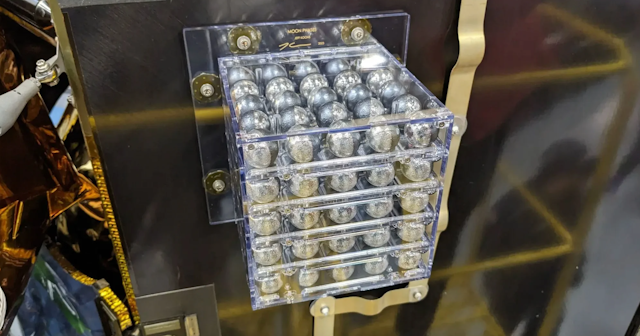To paraphrase an old advertising slogan, Jeff Koons is the Heineken of the art world – a maverick who has always done his utmost to refresh the parts other arts cannot reach. Born in Pennsylvania in 1955, Koons has now achieved something truly out of this world: sending his art into space as part of the Odysseus moon landing last week.
Moon Phases, a cube-shaped transparent box containing 125 spherical mini-sculptures (each approximately 2.5cm in diameter) over five levels, landed on the lunar surface on February 22, on board the US spacecraft.
Each sphere contains the name of a (dead) human luminary, ranging from Aristotle to Ghandi, Ada Lovelace and David Bowie, all decided on solely by Koons. You can see the full list here.

Moon Phases is now being described as the first “authorised” work of art on the moon. Digital arts and technology company NFMoon and 4Space, a space company with strong links to NASA, approached Koons with the idea of sending his artwork to the moon because of “his ability to bridge art and science, reflecting the expansive possibilities of the humanities”.
Or perhaps the two companies understood well that the controversial American artist would provide some extra rocket fuel for their project. Koons is, after all, the man who proclaimed: “The job of the artist is to make a gesture and really show people what their potential is. It’s not about the object, and it’s not about the image; it’s about the viewer. That’s where the art happens.”
Still, it is hard to imagine – even ignoring the practical challenges – that this will lead to a whole host of artists queuing up and begging NASA to send their art into space, but it makes perfect sense for the hero of the hour.
Koons, who currently holds the world auction record for a living artist, courtesy of his Rabbit sculpture, which sold for US$91.1 million (£72m) in 2019, has always been as much a media phenomenon as anything else. He is arguably more famous for having been married to Cicciolina, the Italian former porn star-turned politician, than for any of his creations.

He may sound kitschy and a bit ridiculous, but he is hard to resist. Having borrowed one of his pieces – Basketball (1985) – for a history of bronze sculpture over the last 5,000 years exhibition I organised at the Royal Academy in London in 2012, I ought to know.
However, recently his prices (as measured by auction sales, prices achieved in private sales are not in the public domain) have plummeted. In fact, last year almost 40% of the 292 Koons lots offered at auction failed to find buyers. So he has every reason to want to revitalise his professional fortunes – his actual fortunes are probably less of a worry, given that estimates of his personal wealth hover around $400 million.
What’s more, terrestrial equivalents of the moon sculptures in the form of non-fungible tokens (NFTs) are being offered by his gallery, Pace, and it may be assumed they are not exactly being given away.
So who’s on the list?
Arguably the most interesting thing about the whole circus is the fact that each sculpture carries somebody’s name (with the exception of one called Atom). At some level, the idea is that if aliens come upon Moon Phases, they will be equipped with a handy list of the best of the best in human history. In the meantime, the rest of us can brood on Koons’s choices.
The work itself explains neither their selection nor their configuration, but the vast majority fall into straightforward enough categories, such as religious leaders, rulers, philosophers and scientists. But there is also a striking US emphasis on abolitionists and black leaders. In the performers category – with the exception of Russian ballerina Anna Pavlova – are all either from the US or the UK.
Within each category, many of the choices are predictable enough (Jesus and Buddha, Plato and Aristotle, and so on), but others are more baffling. In the context of the arts, there are only four composers (JS Bach, Mozart, Beethoven and Tchaikovsky), there are no novelists from the periods between Austen and Proust, and there is room for Andrea del Verrocchio, an important but slightly obscure 15th century Italian sculptor, but none for old masters like Vermeer or Velázquez.
Last but not least, a very small section is avowedly given over to personal favourites, a selection that includes such oddities as actor Lucille Ball and art dealer Ileana Sonnabend.
The obvious party game here is compiling one’s own top 125 and seeing where it agrees and disagrees with Koons’. And it would be no less fascinating to speculate who might have made the list had one accompanied Neil Armstrong’s “one giant leap for mankind” on 20 July 1969. Intriguingly, explorers Columbus and Magellan, flight pioneer Amelia Earhart and 19th century Native American guide Sacagawea are in for Koons – but Armstrong doesn’t make the cut.
What is abundantly clear is that 55 years ago there would undoubtedly have been fewer women and people of colour included. Perhaps it could be said that our far-from-perfect species has managed to improve itself over the past half-century or so.
But in terms of art itself, this is a masterstroke of self-promotion on the part of Jeff Koons, and perhaps an achievement that will inspire the next generation of artists to view space as a new frontier for their work.
For the 69-year-old Koons, clearly fame is a seductive experience – perhaps wealth is not enough if you no longer feel relevant or important. It seems the kitschy New York artist has pulled off one of the great art stunts of the century. So far.

Looking for something good? Cut through the noise with a carefully curated selection of the latest releases, live events and exhibitions, straight to your inbox every fortnight, on Fridays. Sign up here.

